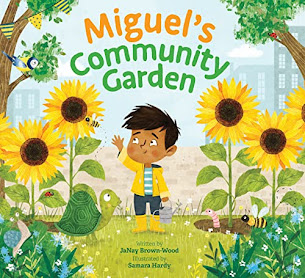Sharing books about main characters with disabilities promotes awareness and acceptance. The three books I will be discussing today also happen to have connections to my summer series on Tips for Connecting Books to Summer Fun. They are all fiction titles, but one is about gardening (albeit in dystopian Australia). One is about wild birds, and another ends with a concert in the park.
A good place to find some of the best books featuring characters with disabilities is on the American Library Association (ALA) website page for the Schneider Family Book Award. The purpose of the award is to honor an author or illustrator for a book that, "...embodies an artistic expression of the disability experience for child and adolescent audiences." Every January, the ALA announces winners in the age categories of 0-8, 9-13, and 14-18. Some of the highlights for the recent 2022 awards are below.
The winner in the young children's category was My City Speaks. Photographer Darren Lebeuf and paper artist Ashley Barron have created a visually engaging tale of a girl with a visual impairment and her father as they travel to familiar spots in their city (including a community garden) and finally arrive at a concert stage in the park where she plays the violin.
The winner in the middle-grade category was A Bird Will Soar, by Alison Green Meyers. It is written from the perspective of Axel, a boy on the autism spectrum who loves birds but often finds family confusing. He makes sense of the people around him by comparing them to birds. The insight into Axel's inner thoughts and feelings is part of what makes this book so remarkable. When a storm destroys an eagle's nest, Axel must help a struggling eaglet to heal. The story is filled with poems and lots of interesting bird facts.
The winner in the teen category was Words in my Hands, written and illustrated by Asphyxia and published by Annick Press. It is an illustrated novel told in a combination of text, paint, collage, and sketch about a girl who is deaf and is living in a slightly futuristic world in Australia filled with food insecurity, political upheaval, and environmental turmoil. It is dystopian but at the same time frighteningly realistic. Ultimately it is a story of resilience and hope as Piper, the main character, strives to create a sustainable garden and find her "voice." Asphyxia, the author/illustrator, is deaf and has included a "Dear Reader" note at the end of the book that shares ideas for how the hearing can be more sensitive and inclusive of people with hearing challenges.
For books about gardening for younger readers, see the books in last week's blog post about Books on Community Gardening and Pollination.
Since May is Better Speech and Hearing Month, you may want to check out the book list I created last November about Children's Books Featuring Main Characters with Speech, Language, Learning, and Hearing Challenges. Because many kids with speech and language challenges also struggle with reading, you may also want to share stories from my list of Children's Books Featuring Main Characters with Dyslexia. Don't forget the list I shared in April for Autism Awareness Month.
Watch for more book titles and tips including activities for Real-World Writing by following this blog. Sign up for my newsletter HERE to receive the free writing template for Travel Trouble.








